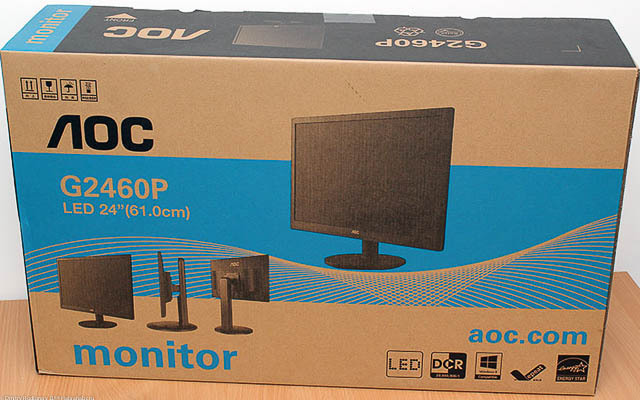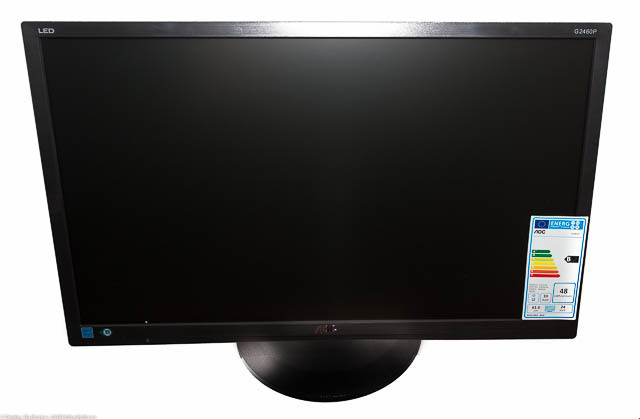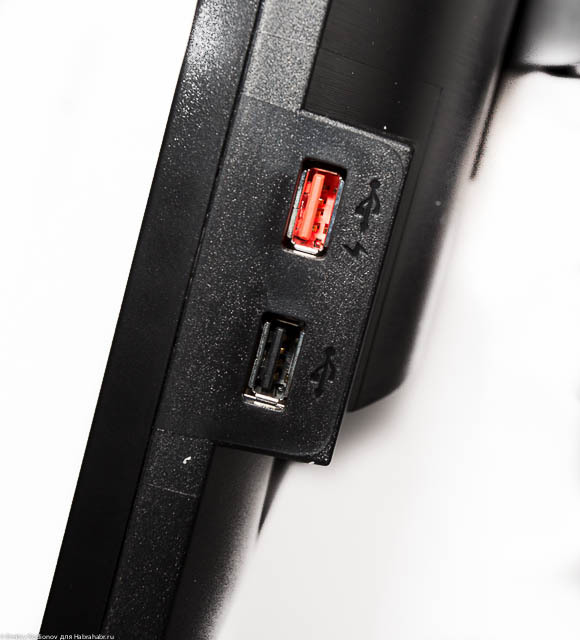A small overview of the monitor AOC G2460Pqu - 144 Hz to the masses
TV manufacturers have taught us to race update frequency - 100, 200, 400 Hz - who is more? In the market of monitors, the situation is a little calmer, but nevertheless for gamers they recommend an update frequency of 144 Hz. But ... Remember this advertising: "If you can not see the difference - why pay more?". In my hands, the AOC company monitor turned out to be; by the example of which I, of course, have an amateurish look, I will try to understand - do I need it? Under the cut I will understand.

I'll start with a passport:
')


On tsiferkam as usual everything is beautiful and nothing is incomprehensible. The sticker on the back side gives the Dutchman of Chinese origin. Since I own an ASUS PA238Q, I will naturally compare it with the AOC G2460Pqu. What does the manufacturer offer except for a passport: The device comes in a box of standard monitor dimensions, no frills: brown cardboard without glossy printing.

In the box: monitor, power cable, DVI cable, VGA cable, USB cable (for connecting the built-in USB hub) and audio cable (for connecting the built-in speakers). Stop, and where is HDMI and Display Port? AOC does not consider it necessary to add these cables to the package - sadly, it’s not a cheap device, and besides it is gamer-oriented. In the meantime, gamers ran to the store for cables digging further. Even in the box there was a CD with drivers and software and a coupon for Shoot Mania - the toy is quite fresh and valuable, but still I would prefer the cables =). What does the gamer offer to put on the table? The rigorous design of the plastic case suggests that gamers are no longer considered crows, who rush to any piece of red glossy plastic.

The frame around the screen has a texture similar to brushed metal - a good solution, fingerprints will not be visible, and dust will sit less.

The control buttons are hidden on the lower right side - though the icons are very difficult to distinguish, but as a rule, the adjustment occurs once, and then it becomes not so significant.

On the right side of the monitor there are two USB connectors - one of them, red, is designed for charging gadgets. The current strength is not specified, but all available smartphones happily took charge and no one complained about the lack of current. By the way, the red port will work on charging, even if the USB cable is not connected to the computer.

The remaining ports are located behind the monitor and look down, so when using VESA there will be no inconvenience of connection. The monitor is equipped with four ports - DVI, VGA, HDMI, DP - besides this there are 2 more USB ports, audio input and output. Enough set for different users.


There is a holder for cables on the monitor's leg so that the bundle of wires has at least some kind of slimness. There are some other important details, for example, a sticker with information about the monitor's power consumption: according to this data, in St. Petersburg such a monitor will cost the owner about 2000 rubles a year if will be permanently on. Well done AOC.

And a gentle theoretical retreat: the higher the refresh rate of the picture, the smaller the gaps between frames, according to my gaze a smooth picture of the world should appear, not only in games, but also when playing any other content. With appearance everything is clear, gamers came running from the store with the Display Port cable, it's time to play. Where do we need a high refresh rate? That's right, in shooters. The freshest Titanfall has one interesting feature - FPS is equal to the screen refresh rate - accordingly, the bonus from the 144 Hz frequency became noticeable when the monitor was changed. In the old CounterStrike: GO, the picture did not change for my taste. Watch Dogs became more tender, perhaps, the picture stopped twitching, and Dota2: it also became a bit more pleasant to play, jerks were lost when moving around the map. , loops behind letters do not drag on. Oh yes, of course, about the price - they ask for a device for 11,000 rubles =) Subjectively, I would not change my ASUS for this miracle of technology, but this is only because the games are not my main profile. buying from scratch, there is a serious sense to look at the AOC G2460Pqu. He has very few drawbacks, judging by the testing of serious publications with color coverage, everything is also in order, except that you can complain about the price, but you have to pay for everything good.

I'll start with a passport:
| AOC G2460Pqu | |
| Screen | |
| Diagonal inches | 24 |
| Aspect ratio | 16: 9 |
| Matrix Coverage | Matt |
| Standard resolution, pix. | 1920x1080 |
| PPI | 91.79 |
| Image Parameters | |
| Matrix type | TN |
| Backlight type | White LED |
| Max. brightness cd / m 2 | 350 |
| Static contrast | 1,000: 1 |
| Dynamic contrast | 80,000,000: 1 |
| Number of colors displayed | 16.7 Million |
| Horizontal scanning frequency, kHz | 30 ~ 157 |
| Vertical scanning frequency, Hz | 55 ~ 160 |
| GtG response time, ms | one |
| Maximum horizontal / vertical viewing angles, ° | 170/160 |
| Connectors | |
| Video inputs | 1 x Dual-link DVI-D; 1 x DisplayPort; 1 x HDMI; 1 x D-SUB |
| Additional ports | 4 x USB 2.0 Type A; 1 x USB 2.0 Type B; 1 x audio input (mini-jack 3.5 mm) 1 x headphone output (mini-jack 3.5 mm) |
| Built-in speakers: number x power, W | 2 x 2 W |
| Physical parameters | |
| Screen position adjustment | Tilt angle, turn, portrait, height adjustment |
| VESA mount: dimensions (mm) | 100 x 100 |
| Kensington lock | Yes |
| Power Supply | Built |
| Max. power consumption: in operation / standby (W) | 25–33 / 0.5 |
| Overall dimensions (with stand) LxHxD, mm | 565.4 x 403.05 x 219.3 |
| Net weight (with stand), kg | 6.54 |
| Warranty period | > 3 years |
')


On tsiferkam as usual everything is beautiful and nothing is incomprehensible. The sticker on the back side gives the Dutchman of Chinese origin. Since I own an ASUS PA238Q, I will naturally compare it with the AOC G2460Pqu. What does the manufacturer offer except for a passport: The device comes in a box of standard monitor dimensions, no frills: brown cardboard without glossy printing.

In the box: monitor, power cable, DVI cable, VGA cable, USB cable (for connecting the built-in USB hub) and audio cable (for connecting the built-in speakers). Stop, and where is HDMI and Display Port? AOC does not consider it necessary to add these cables to the package - sadly, it’s not a cheap device, and besides it is gamer-oriented. In the meantime, gamers ran to the store for cables digging further. Even in the box there was a CD with drivers and software and a coupon for Shoot Mania - the toy is quite fresh and valuable, but still I would prefer the cables =). What does the gamer offer to put on the table? The rigorous design of the plastic case suggests that gamers are no longer considered crows, who rush to any piece of red glossy plastic.

The frame around the screen has a texture similar to brushed metal - a good solution, fingerprints will not be visible, and dust will sit less.

The control buttons are hidden on the lower right side - though the icons are very difficult to distinguish, but as a rule, the adjustment occurs once, and then it becomes not so significant.

On the right side of the monitor there are two USB connectors - one of them, red, is designed for charging gadgets. The current strength is not specified, but all available smartphones happily took charge and no one complained about the lack of current. By the way, the red port will work on charging, even if the USB cable is not connected to the computer.

The remaining ports are located behind the monitor and look down, so when using VESA there will be no inconvenience of connection. The monitor is equipped with four ports - DVI, VGA, HDMI, DP - besides this there are 2 more USB ports, audio input and output. Enough set for different users.


There is a holder for cables on the monitor's leg so that the bundle of wires has at least some kind of slimness. There are some other important details, for example, a sticker with information about the monitor's power consumption: according to this data, in St. Petersburg such a monitor will cost the owner about 2000 rubles a year if will be permanently on. Well done AOC.

And a gentle theoretical retreat: the higher the refresh rate of the picture, the smaller the gaps between frames, according to my gaze a smooth picture of the world should appear, not only in games, but also when playing any other content. With appearance everything is clear, gamers came running from the store with the Display Port cable, it's time to play. Where do we need a high refresh rate? That's right, in shooters. The freshest Titanfall has one interesting feature - FPS is equal to the screen refresh rate - accordingly, the bonus from the 144 Hz frequency became noticeable when the monitor was changed. In the old CounterStrike: GO, the picture did not change for my taste. Watch Dogs became more tender, perhaps, the picture stopped twitching, and Dota2: it also became a bit more pleasant to play, jerks were lost when moving around the map. , loops behind letters do not drag on. Oh yes, of course, about the price - they ask for a device for 11,000 rubles =) Subjectively, I would not change my ASUS for this miracle of technology, but this is only because the games are not my main profile. buying from scratch, there is a serious sense to look at the AOC G2460Pqu. He has very few drawbacks, judging by the testing of serious publications with color coverage, everything is also in order, except that you can complain about the price, but you have to pay for everything good.
Source: https://habr.com/ru/post/231707/
All Articles